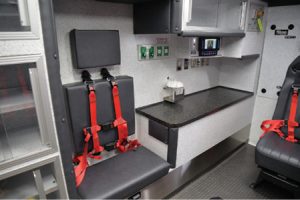Standardized lines of ambulance models continue to see strong customer support, but most manufacturers also are altering their designs to accommodate specific requests from end users.
Ambulance designs are changing to reflect not only safety concerns from customers but also specific requirements for equipment placement.

Steve Rowland, regional sales manager for USA South at Demers Ambulances USA Inc., says that many of the design changes on Demers ambulances involve mobility seating within the patient module. “We are seeing more and more departments go to a captain’s chair on a sliding and rotating track on the curb side of the module where they can treat a patient,” Rowland says. “We are seeing more of them replacing the squad bench, although the industry probably will never fully get away from the traditional squad bench.”

Chad Newsome, national sales manager for PL Custom Emergency Vehicles, says that in terms of ambulance design for safety, “we want to keep butts in the seats. We have the Medic In Mind system, where the person working with the patient is able to stay seated and belted in and yet can still reach all of the equipment needed to treat the patient.” Newsome adds that the design of PL Custom’s ambulances include radiused strike points in all of its modules to prevent injuries. “All strike points on our Corian-type countertops are cut at 45-degree angles,” he says, “and all seats with swivel bases have six-point harnesses.”

Chad Brown, vice president of sales and marketing for Braun Industries Inc., notes that Braun designs its seating configurations and seat belt restraint systems with ergonomics of the medics in mind. “We usually place heavy-use items beside the seating instead of in the overheads,” he says. “We’ve done ride-alongs with customers to visualize where and how they use their equipment and make suggestions on where they could be located in the module. Cabinets, cot retention, and seat belt restraint systems testing has been a big focus for us in the past 24 months.”




